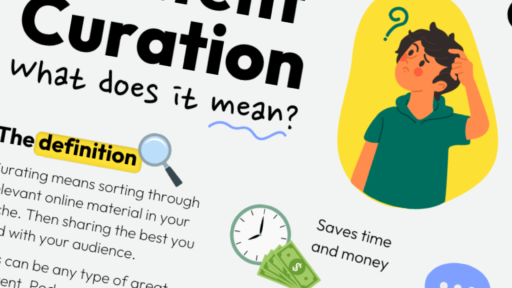A lot of SEO is guesswork. But backlinks (and the process of link building) are crucial.
If you want to increase organic traffic to your site, you need a lot of them. But not just from any old site.
If you’re a new business, you might be clueless of where to start. How do you know what Google will and won’t penalize? What’s the difference between dofollow and nofollow links? Does the anchor text make a difference?
This ultimate backlink guide explains everything you need to know about these links and their impact on search rankings. Plus, we’ll outline a strategy for gaining high-quality links to your website from 16 external sources with authority and large audiences.
- What are backlinks?
- Not all backlinks are created equal
- 6 types of backlinks and how to use them to build your profile
- 16 tools and platforms to build backlinks and brand awareness
- 6 backlink methods to avoid
What are backlinks?
Backlinks are links from external sites to yours.

Search engines use links to crawl the web. They view backlinks as “thumbs up” for your website. The more of these you get, the higher you’ll rank on the SERPs (search engine results pages.)
They’re the basis of search engine optimization and have a huge impact on Google’s algorithm, PageRank.
This algorithm has changed so much over the years, but there’s one thing everyone agrees on—your backlink profile is the most important ranking factor.
So, are hundreds of links from one site a good thing? Yes and no.
Not all backlinks are created equal
A good link has a few key factors:
- It comes from a reputable website with high-quality content
- It’s relevant to your niche and site
- The website linking to you has a high level of authority
There are lots of variables that can affect them too. Things like:
- Domain authority rank
- Anchor text
- Contextual backlinks vs. non-contextual
- Nofollow and dofollow
- Referring domains
Domain authority rank
There are over one billion websites worldwide, but not all have the same level of influence. Wikipedia has more sway with Google than a local blog page because the Wikipedia team has built up a reputation as an authority in their field over time.
So, what’s yours? Well, SEO tools display your site’s estimate as a score out of 100. They all have different names for it too—Domain Authority (DA), Domain Rating (DR), Authority Score (AS), etc. The metric means the same thing, but each tool markets it differently.
Here’s Moz’s Domain Authority:

And Ahref’s Domain Rating:

It’s not an official Google ranking factor, but it can be a good indicator of where you stand in relation to your competitors. The higher your score, the more trust Google likely puts in you as an authority site and your external links.
The ultimate goal is to increase your level of trust and earn backlinks from these sites with high domain authority. Is it hard to get backlinks from websites with such a good rep? Absolutely—but they’re incredibly valuable.
Anchor text
The anchor text is designed to stand out in a sentence, so readers know it’s clickable. When readers do, they’ll be taken to the linked URL.

It’s good practice to use the focus keywords of the linked content as the anchor text just so it’s clear. For example, if I were writing about brand voice—I’d link to those words.
It doesn’t actually have much of an impact on rankings. Backlinks from websites where the anchor text is “click here” won’t be as obvious to the reader, but Google looks around the anchor text to determine the relevance.
Contextual backlinks vs. non-contextual
Contextual links appear in the main body of content surrounded by text. They’re relevant to the paragraph they’re in and read naturally. These also have a higher SEO value than those that are placed elsewhere.

A non-contextual backlink is usually found in the author bio (at the end of a blog post) or the sidebar—these often link to social media profiles or other personal websites. Because they’re not as relevant, Google struggles to accurately determine how closely related the two pages are and will likely disregard them.
Nofollow and dofollow
There are two types of links that webmasters can add to their pages. Up until 2005, all links were dofollow. Google added nofollow links to crack down on black hat link-building techniques.
Black hat SEO practices intentionally go against search engine guidelines. These are things like:
- Keyword stuffing (using the same keyword over and over to try manipulate ranking)
- Cloaking (showing one piece of content to readers and another to search engines)
- Paying for links

If you’re found using these (and you will be), you’ll be penalized.
Dofollow links pass on authority from the host page to the linked website. Basically, they tell Google your website is trusted. This vote of confidence then improves search engine rankings over time.
Most social media platforms (Facebook, Twitter, LinkedIn, Instagram. etc.) all use nofollow links. These types of links tell search engines not to count them toward search rankings, but that doesn’t mean they’re not valuable. Lots of authoritative websites use them, which can still result in increased quality traffic, brand awareness, and trust.
Nofollow links include the code rel=“nofollow”. The “rel” gives context about the relation of the linking page to the target.

Semrush tested a theory in 2017 of the value of these types of links. The team was still able to rank number one on Google for their chosen search term using only nofollow links. This might not be the case anymore, but it’s worth remembering before you disregard them.
Referring domains
Referring domains are the unique websites your backlinks come from. Lots of links from the same website are great (especially if they’re all high quality), but multiple backlinks from the same site still only count as one referring domain.
So, why does increasing the amount of referring domains matter? Well, aside from SEO, Ahrefs found a positive correlation between the number of unique referring domains and the amount of search traffic a web page received.

As they said themselves:
“While correlation doesn’t equal causation, the results of the study suggest that the more backlinks from unique websites (referring domains) you have, the more traffic you’re likely to get.”
So, yes. The number of backlinks you have is really important. But the number of high-quality referring domains is even more so.
6 types of backlinks and how to use them to build your profile
There are many ways to earn backlinks from external websites. Some require little effort, while others need a lot of help once you publish.
This Backlinko case study analyzed 11.8 million Google search results and found the top result had an average of 3.8x more backlinks than positions 2-10.

So, let’s look at some popular ways to increase your link profile:
- Naturally-earned links
- Finding broken links
- “The Moving Man Method”
- Guest blogging
- Finding mentions without backlinks
- Repurposing top content for other platforms
1. Naturally-earned links
Some people will naturally link to your content when you post it because they find it useful. If you’re getting these types of backlinks, your content is giving your audience something they need.
If you’re not getting any, first look at the quality of your content. This is the most important factor for ranking on Google—creating useful, relevant content that answers people’s questions.
Try employing the steps from Skyscraper Technique to create a piece of content that’s better than anything else out there.

Another way of earning links naturally is by mentioning industry experts, influencers, and brands in your article. Once it’s published, get in touch with them and let them know. If it’s a top-quality piece, there’s a good chance they’ll share it with their audience.
Want to reach out automatically? Mentioned scans your content to identify people and companies you’ve mentioned, then sends email campaigns to let them know.
If low-quality content isn’t the issue, make sure users can find it themselves. Read up on Google Search Essentials (formerly Webmaster Guidelines) to make sure you’re properly indexed and visible.
You should also have a solid distribution strategy for everything you publish. This could include:
- Sharing on social media
- Sending to other sites (more on that soon)
- Using content promotion tools
Don’t forget internal links in anything you post, either. These help visitors navigate your site more easily and find other content relevant to their search. Plus, Google loves ‘em.
2. Finding broken links
Broken links and 404 errors are bad for SEO, and you should make sure you don’t have any on your site. Broken link-building (in this case) means looking for these errors on other sites that could potentially link to your content. The easiest way to find these is through an SEO tool or resource pages relevant to your brand.
Here’s one Moz made for keyword tools:

These particular pages are full of links to external quality websites. And if the page hasn’t been updated in a while, some of them may lead nowhere. So, how do you find those in your own niche?
Try some manual searching first. Head to Google and search for:
- “[Your niche] resource list”
- “[Your niche] resources”
- “[Your niche] recommended sites”
- “[Your niche] links”
If you use Google Chrome, the Check My Links extension can highlight all broken links on a page. Then you can get in contact with the website and let them know.

You don’t have to ask them outright to link to your content, but gently tell them your brand operates in the same niche and could be helpful to them. They may still not mention you—but don’t ask, don’t get.
3. “The Moving Man Method”
The Moving Man Method is a link-building strategy invented by Backlinko’s Brian Dean. It’s similar to the above but focuses on outdated or recently rebranded web pages—meaning they’re no longer relevant.
There’s so much old content that’s waiting to be replaced by your more relevant and better-quality site. Here’s the three-step method for success:
- Find companies in your niche that are no longer operating or updating their site
- Use an SEO tool to find all the sites that link to it
- Contact the site owners and suggest your content as an alternative
Here’s a template of what you could say:
“Hey there.
I’ve come across [link with old mention] and noticed you were linking to [old company].
[Old company] has unfortunately gone out of business, so you may want to remove that mention to make sure it’s as up-to-date as possible.
I’ve published a similar resource that might help: [your link].
No worries if not—I loved the post and learned a lot!”
Or here’s an example from the creator of the technique himself:

Again, it’s not guaranteed to work. But worth a shot.
4. Guest blogging
Guest blogging is writing content for other websites that (usually) includes a link back to your site. It’s also widely stated as a way to build high-quality links that help you rank. But is this still the case?
Former head of Google’s webspam team Matt Cutts told us in 2014 that guest blogging was over. He referred to the kind of emails that I see all the time:

In 2020, Google’s Search Advocate John Mueller confirmed this by saying the platform frowns upon and devalues guest posts that are just for links:
Buffer built their customer base to 100k through guest blogging back in 2012. But just because it’s good for brand-building doesn’t mean it affects ranking.
If you want to use it for brand awareness, it can be a great tactic. But to build backlinks for your SEO strategy? Take it from the experts at Search Engine Journal (with a DR of 91):
“There is literally nothing to disagree with. Mueller wasn’t stating an opinion, he was saving the SEO community from wasting time and money trying to rank with a technique that largely does not work.”
5. Find mentions without backlinks
So, what about those sites that have already mentioned you but haven’t linked? This is another simple method but it can take a bit of time. However, it’s not quite cold outreach and will be worth it if you gain new backlinks or referral traffic.
Start by heading to Google and searching for: “site: [your brand name]”:

Then do some manual digging. Analyze the first few pages and see if there are any missed link-building opportunities. If there are, reach out to the publishers and see if they’ll update those unlinked mentions with some anchor text.
You might want to try any misspelled versions of your business name too. You wouldn’t believe the amount of “Quu” and “Quuuu” mentions we find.
6. Repurpose top content for other platforms
You likely already know which of your site’s content earns the most traffic, converts the most customers, or retains visitors for the longest time. If you don’t, check out a tool like Google Analytics.
Once you’ve found your winners, think about making them work harder for you by refurbishing for other platforms (Slideshare, YouTube, Instagram, Quora, etc.)
For example, one long video can become lots of short ones or a blog post:
Plus, it puts your content in front of a completely new audience each time.
It also works for pieces that aren’t performing as well. Give them another chance by upcycling. Turn blog posts into podcasts. Data into infographics. Go for a format that’s super shareable, and watch those inbound links stack up.
16 tools and platforms to build backlinks and brand awareness
As well as sites related to your brand, there are a host of other platforms where you can share your content and earn backlinks. You should consider each of these for your link-building campaign, but don’t put the same amount of effort into them all. (We’ve listed pros and cons to make this bit easier.)
Some websites listed below use nofollow links but have high domain authority. These may not affect SEO directly but can increase your organic traffic and build trust.
- Mentioned
- Medium
- HARO
- Digg
- BizSugar
- Rhino Rank
- GrowthHackers
- Discord
- Quora
- Ahrefs
- SourceBottle
- Newswires
- Resource lists
1. Mentioned
Mentioned works a little differently to the other link-building tools and platforms on this list. When you quote or source an industry expert or influencer, it’s good practice to reach out to them to let them know. More often than not, they’ll be happy to share your post on social media.
But this process can be really time-consuming. So, instead of spending hours finding contact information or sending emails one by one, you can automate the entire process with Mentioned.

Once you’ve published a post, simply input the URL into Mentioned and it’ll scan for names and contacts within. You can choose from that list who to contact and who to ignore.
With the click of a button, you’ll send out an email that notifies that person or brand contact that you’ve mentioned them with the link to your article.
| Pros | Cons |
| Huge time-saver | Some people don’t make their contact information public |
| Helps build relationships with influencers in your niche | Doesn’t always guarantee a backlink |
| Builds brand awareness | Influencers may want something in return for a backlink |
2. Medium
Medium is a popular free-to-use blogging platform. Anyone can use it, so it has a wide user base of professionals and amateurs writing about their interests.
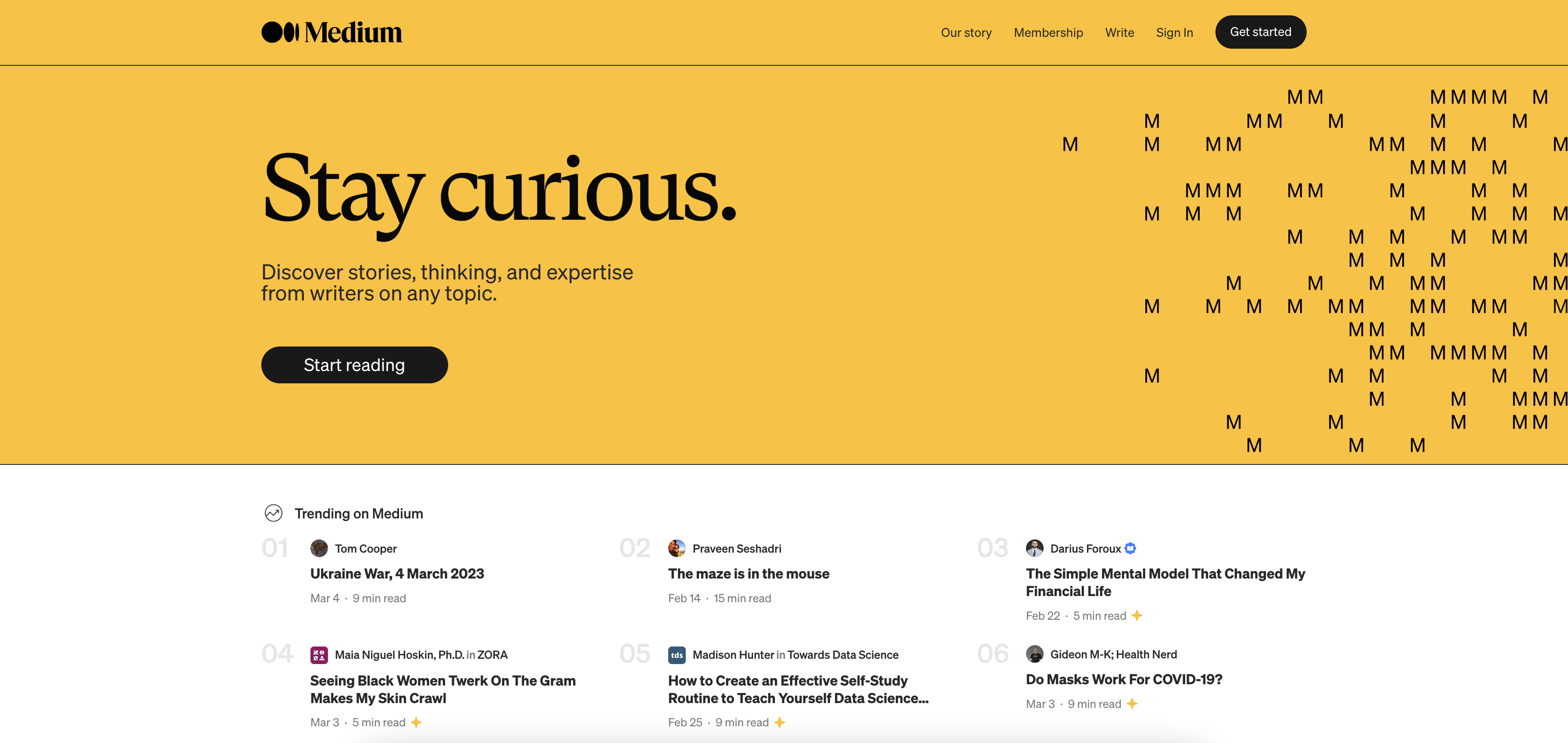
First, you want to interact with others within your niche. Comment on their posts and engage in conversation. Once you’re part of the community, you can start posting your own content.
There are two strategies for posting here. You can paste your own blog posts that already exist. Or create unique content just for Medium. Pasting your own content is obviously the easiest route, and you won’t lose any clout in terms of SEO. But it doesn’t really give readers any reason to head to your homepage.
Creating unique posts for Medium is time-consuming, but it means you can get involved in conversations on the platform and create content that you know the community wants to read.
| Pros | Cons |
| Huge audience | Backlinks are nofollow |
| High domain authority | Creating unique content takes time |
| Don’t need to worry about SEO writing | A lot of competition for attention |
3. HARO
HARO (Help a Reporter Out) is a three-times-a-day email (from Monday-Friday) that gives you the opportunity to be quoted by journalists. The requests include a few things:
- The query
- Requirements to be considered for inclusion
- Deadline date
- An anonymous email address to pitch your insights or comments

HARO has the potential to provide your brand with backlinks from some of the largest publications in the world (Reuters, TIME, The Wall Street Journal, etc.)
Every email you receive features a wide range of questions from journalists and writers. If there’s one you can answer and provide some expertise, simply reply.
You can opt to receive questions only covering certain topics or across all sectors. And according to Brian Dean, it can be “one of the best ways to build high-quality backlinks at scale.”
| Pros | Cons |
| Potential exposure on huge websites | You may be mentioned but not linked |
| Useful for building working relationships | Have to respond before the deadline |
| Free to get involved | Your answer may not be used at all |
4. Pinterest
Pinterest is a free social media platform described as a “visual discovery engine” for finding inspiration and new ideas. The idea is to create “boards” which are like separate categories for your images.

Infographics are one of the most shareable types of content. So, it makes sense to post them on Pinterest and link through to your site’s original URL.
Just remember, Pinterest links are nofollow. But they could still result in more organic traffic.
| Pros | Cons |
| Free to use | Niche audience (mostly female) |
| Increases brand awareness | Can be time-consuming to upload lots |
| Great for driving referral traffic | Automating it can be expensive |
5. Digg
Digg is a free content curation and news aggregator with two main ways to use it. You can create unique content that will be hosted there. Or you can paste the URL of a blog from your site and Digg will send users there.

Digg has 73 different subject categories called Namespaces. Users can follow these if they want quicker access to certain subjects. However, there still appears to be no search function—which may hinder the amount of traffic articles on Digg receive.

The community appears to be much less active than on Medium, so I’d recommend jumping straight into sharing your own content if you try it out.
| Pros | Cons |
| Wide audience | Not as popular as other community sites |
| High domain authority | Creating unique content takes time |
| Popular content gets a dofollow link | No search function |
6. BizSugar
BizSugar is a community-based platform for professionals to share business content from their industry. This can help build brand awareness and your reputation as a thought leader.

Much like Medium, the best way to use BizSugar will be to get involved with the “Mastermind Community” first and interact with other users. This free discussion area is where you can find help and provide advice to others.
Once you’re part of the community, you can begin posting your own content. There’s a specific sharing section for this, so save your thought pieces for there.

The community upvotes content with “Sugars”, bringing the highest quality pieces to the top of the page. It could be a lot of effort with not much payback, but you won’t know until you try.
| Pros | Cons |
| Wide range of topics | Outdated front-end UI (user interface) |
| Daily email showing your posts’ engagement | Not as authoritative as similar sites |
| Great place for networking | Not as good for personal blogs/niche topics |
7. Flipboard
Flipboard is a news aggregation website with a similar audience size to Medium. However, it doesn’t require the creation of any unique content. As an aggregator, Flipboard collects already-published content and puts it all in one place for its users.
Here’s what your Flipboard profile could potentially look like:

Magazines on your profile are used to organize your content. Storyboards are smaller, more focused magazines with a limited number of articles.
The easiest way to use the platform is to add your blog’s RSS feed to your Flipboard profile. Then every article you post will automatically show up.
Adding the share button to your articles enables others to get it in front of their community on the site. Thus, expanding your reach.

| Pros | Cons |
| Really polished UI | Huge competition |
| Personalized content means you get in front of the right people | Can’t post traditional backlinks with anchored text |
| Free to use | Some content isn’t easily accessible |
8. Rhino Rank
Rhino Rank is a link outreach agency that builds organic links to your website. Their employees reach out to content relevant to your audience and pitch a link back to yours.
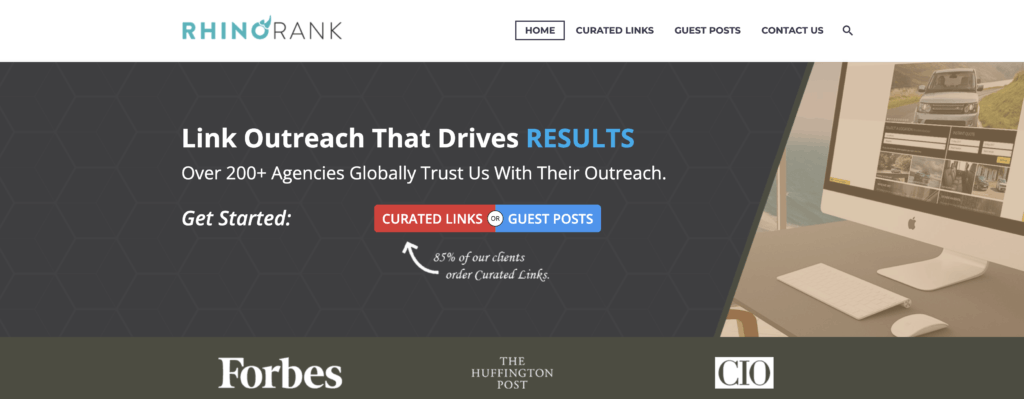
You provide the URL and anchor text you want to use, then pay for every successful link they acquire. Rhino Rank guarantees the link will be live for 12 months. (But, they can’t really promise this because it’s at the will of the external website.)

They also use guest posts as part of their strategy, but these work slightly differently from the style mentioned above. Instead of creating the content yourself, Rhino Rank reaches out to bloggers, journalists, and website owners in your niche to convince them to promote something their staff will make.
If they get a positive response, they write an article on behalf of you and send it to the website for publication with backlinks.
| Pros | Cons |
| Won’t be penalized by Google because payment is for the outreach rather than a link | Any site could remove your backlink at any time |
| Trusted by big companies with authority (Forbes and Entrepreneur) | Guest blogging isn’t a strong link-building tactic anymore |
| Someone else does the time-consuming work | Could become pretty expensive |
9. GrowthHackers
GrowthHackers is a community for professionals focused on (you guessed it) growth hacking. It’s a relaxed format where you can share advice and “pick the brains of fellow community members on your burning questions about growth, marketing and experimentation.”

As with other community-led platforms, start by interacting with other users’ posts. Once you’re part of the conversation, you can start posting your own content. Unique thought pieces that don’t appear too spammy are recommended.
There’s a free forum for startups and small businesses. Plus, an invite-only Enterprise version for high-level connections. If you’re in the marketing game, this platform could be for you.
| Pros | Cons |
| Dofollow links are allowed where they are relevant to the topic being discussed | Will take time to establish authority in the community |
| Lots of educational content to learn from | Being overly promotional isn’t allowed |
| Build your brand’s presence and authority (resulting in more natural backlinks) | You can’t hide behind your brand (you must be identifiable) |
10. Reddit
You’ve likely heard of and used Reddit. It’s one of the most popular networks of community forums (subreddits) where users can ask and reply to questions. Then other users choose to comment, up, or downvote the answers.
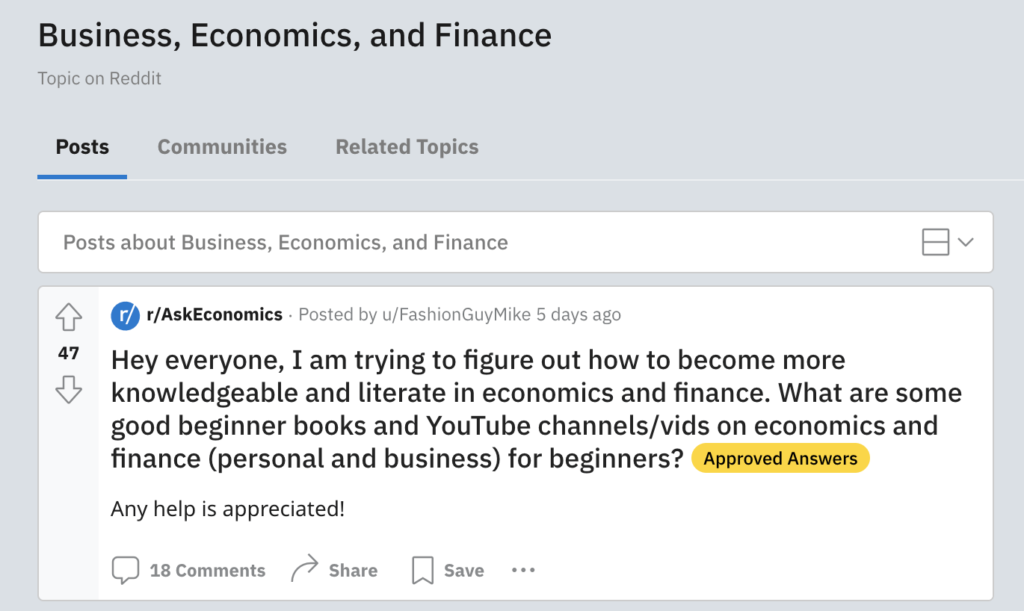
SEO Chatter recommends interacting with your chosen community and building up your karma for 30 days before attempting to post any backlinks. They also recommend contributing 15-20 comments per backlink.
- Comment and interact first
- Link second
Simply promoting your link won’t usually work here—even if it’s great content. There are always exceptions, though. Here’s a subreddit that was once healthy, active, and didn’t seem to punish users for linking to external sites.
Having an account that looks human will also help. So, try using your name instead of your company’s—it’ll also help build your personal brand too.
| Pros | Cons |
| Extremely popular site with plenty of users | Time-consuming to get involved in each community to build trust |
| Highly-targeted audiences | Easy to get penalized for backlinking |
| Can also use it for social listening and see who’s talking about your brand | Most subreddits hate any form of advertising or marketing |
11. Discord
Discord is an instant messaging app with thousands of communities for all sorts of niches. Same goes here—become a trusted member before posting any links to your page.
I joined a marketing channel with 25 separate discussions—including showcasing your work and promoting your website.

This particular server has over 4000 members. While that’s not a huge number, it appears to be an active place with plenty of user interaction and link-sharing.
Other chats won’t be as welcoming to blatant promotion. You can expect that in a marketing Discord, but you’ll need to be more subtle in others. Your main focus should be providing value. If you become a well-known expert resource, you’ll get far more naturally-earned backlinks.
You could also create a Discord for loyal customers to hear and implement their feedback. Plus, get some testimonials to use on your landing pages. The possibilities are endless.
| Pros | Cons |
| Lots of active, dedicated users | Building your presence will take time |
| Huge variation of subjects and industries | Community rules may not allow link-sharing |
| Affordable compared to Slack | Discord isn’t as well known as many of these sites and platforms |
12. Quora
Quora is a social Q&A website where you can collaborate with other users by asking questions and commenting on answers.
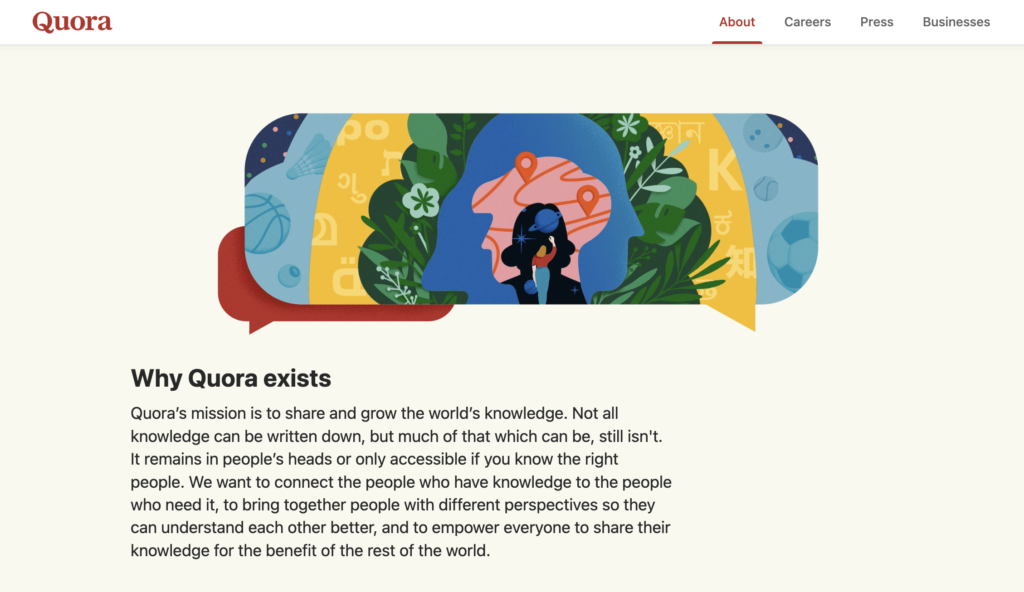
You can create a personal or a business account—both have different advantages.
Creating a personal account puts a face to your answers and shows you’re a human who is genuinely on Quora to help people out. A personal profile also allows you to link your site to your profile page.
A business profile lets you give access to several people and may lend some of your answers more weight.
Again, interact with the community first. Show them you can add value and be trusted before posting any links to your website or content.
Quora has a really high DR of 91. The backlinks here are nofollow, but they regularly show up in the top SERP positions. So, while it won’t count toward your link profile, a popular answer will be seen by a lot of people in your niche.
Even John Mueller says Google doesn’t disregard the platform:

| Pros | Cons |
| You can build authority by offering helpful answers | Can be hard to find active, relevant questions |
| Potential for huge exposure and reach | Lots of competition for the top spots |
| Can give you ideas for content creation | Takes time to become a trusted member |
13. Ahrefs
Ahrefs is a one-stop shop for all your backlinking needs. It’s one of the easiest places to analyze competitors’ backlinks and find places to insert your own.
- Simply head to Ahrefs Site Explorer
- Enter a competing domain
- Click “Best by links”
- Add a “404 not found” filter

Someone else’s missed opportunity is one for you to snap up. Ahrefs shows you where your competition has been mentioned and also lost links. Are those sites where you could be mentioned too? Let them know. If there’s a 404 error you could replace? Let them know.
The outreach part of this process still takes time. But Ahrefs makes finding backlink possibilities almost instant.
| Pros | Cons |
| Opens up opportunities for relevant backlinks | Expensive pricing and no free trial |
| Gives you an idea of the type of content that gets the most backlinks | Only one team member can use at a time |
| A slick, simple UI | Smaller link index than Moz and Semrush |
14. SourceBottle
SourceBottle works similarly to HARO. It’s a great opportunity for free publicity and super easy to use. Head to the homepage and click “I am a source seeking publicity”. Then browse through opportunities to share a piece of content that can act as a source for reporters.
Here are a few displayed below the fold:

- Sign up and choose your topics and source countries
- Receive email alerts with current requests for sources on your chosen topics
- Click for full details of each
- Respond online

Rather than searching for backlink opportunities, why not let this PR platform send them to you? Just be aware, a lot of the publications have strictly Australian users. So, research any you apply for to make sure they’ll be worth it for your business.
| Pros | Cons |
| Lots of opportunities to act as a source for websites with authority | Australia may not match up with your target audience |
| Requests for sources are emailed to you | Outdated UI |
| Free to sign up as a source | You’ll receive ads without a paid subscription |
15. Newswires
Newswires can connect your brand to some of the biggest names in publishing (the BBC, The New York Times, Forbes, etc.) They’re the other side of the coin to HARO. Rather than waiting for relevant queries, you can send press releases to the thousands of global newsrooms in their directories.

Popular sites include Newswire, PR Newswire, and PR Fire. When you think you have a piece of newsworthy content, write a press release. Then send it out to the relevant publications who’ll hopefully use it in a story. (Some platforms will do the writing for you on certain plans.)

They all work a little differently, but the process is similar:
- Upload your press release
- Pay for add-ons that guarantee extra coverage
- Your story is published
- You get the live URLs in a few days
The process may be simple, but the price is high. You’re looking at anything from hundreds to thousands of dollars. For brand awareness, it could be great. For SEO, perhaps not so much.
| Pros | Cons |
| Form great connections with huge publishers around the world | Newswires cost a significant amount |
| No need to wait for a relevant query | Google could penalize having the same content on different sites |
| Acquire high-quality backlinks from trusted sites | There may be little to no SEO value (the links may also disappear after a short time) |
16. Resource lists
Resource lists are pages completely dedicated to linking external websites. These lists are made up of content the brand/webmaster deems useful. I covered them briefly when discussing broken links, but this isn’t the only way to be included in them.
Think you have a resource that belongs on a particular one? Reach out to the publisher and ask to be included. To find others, you’ll need to conduct some Google searches using different strings:
- [Your niche] inurl:resources
- [Your niche] “best resources”
- [Your niche] “useful resources”
- [Your niche] intitle:links
- [Your niche] “helpful links”
Let’s say we’re using the term “content marketing”. Our search term would look like this:

Within the first few results, we found this:
The downside? They’re not always this easy to find, and lots aren’t called “resource lists”. It can take a while to unearth them, but they’re still worth finding for a few reasons:
- There’s usually great SEO value
- They’re generally editorial websites with decent domain authority
- They get lots of backlinks (as they exist solely to link out to other pages)
The example above has this domain rating from Ahrefs:

| Pros | Cons |
| Super linkable | Can be hard to find |
| Outreach is easy and relevant | The site doesn’t always have a good DR |
| Doesn’t cost anything to try | You might not get any links from it |
6 backlink methods to avoid
Google is hot on penalizing the wrong kinds of backlinks. These can be detrimental to your business, so don’t get complacent and opt for the easy option.
They’ll also undermine your brand’s authority and potentially prevent your website from ranking in search engines at all. So, make sure you’re avoiding the following backlinking methods:
| Backlinks to avoid | Reason |
| Private Blog Networks (PBNs) are groups of authoritative websites used to build backlinks for a single website | These money-making schemes artificially increase search rankings to manipulate the algorithm and violate PageRank rules |
| Link exchanges | Swapping hundreds of links in sidebars/footers with irrelevant companies will be caught out |
| Paying for links | Google hunts down anyone buying links and kills their search rankings |
| Spam blog comments with a link back to your site | Google discounts these links because they’re not part of the main content or uploaded by the site owner |
| Low-quality guest posts | Spammy articles on third-party websites will be marked as useless by search engines |
| Cloaking | Adding backlinks that blend in with the background to try to trick search engines will be considered keyword stuffing |
Here’s an example of a guest post you don’t want to imitate:

Badly formatted, full of keyword stuffing and jargon—this guest post isn’t helpful to anyone.
Conclusion
Backlinking is an essential part of digital marketing and SEO—it’s one of the few things Google has confirmed to be important. These types of links can significantly increase your brand’s authority in the industry and help expand your audience.
Some of the tactics mentioned in this ultimate guide won’t boost your ranking efforts, but they could increase website traffic and (hopefully) conversions.
It’s important to get your backlinking strategy right. Try out the above websites and platforms and find out which work best for you. It may take a bit of trial and error, but it’ll be worth it.
Are there any platforms we’ve missed from this backlink guide? Where have you seen the most success? Let us know on Twitter.



